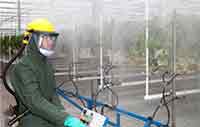Pesticide Risk Reduction Programs
By Allie Gallant
In 2003, the Canadian government instituted the Pesticide Risk Reduction Program to meet growing public demand for sustainable agriculture, reduce reliance on older chemical insecticides and minimize the environmental impact of pest management programs.
This program, similar to ones in the U.S. and Britain, tended to stress the adoption of natural and organic insecticides – this, despite widely divergent results on the relative environmental impact of organic, conventional and Integrated Pest Management (IPM, which uses a combination of both).
Policy is promoting more biopesticides (possibly on the assumption that they are safer than synthetics), but empirical data needs to be used to assess aspects related to human health, such as toxicity and residues, and efficacy.
In order to accurately compare organic and synthetic insecticides in the field, researchers at the University of Guelph in Ontario, Canada used a tool called an Environmental Impact Quotient (EIQ) to compare the relative impacts of 6 different insecticides, organic and synthetic, targeting the soybean aphid, an invasive pest that was likely introduced to North America by edible Edamame bouquets imported from China.
In particular, the scientists measured the rate of mortality of the soybean aphid, and two key natural predators (the multicoloured Asian ladybeetle and insidious flower bug), when exposed to the various insecticides at field rates. They wanted to determine both how effective the products were at targeting the pest, and how they impacted the natural predators that provide biocontrol benefits.
Dr. Rebecca Hallett, Associate Professor with the University’s School of Environmental Sciences, was a Chief Researcher on the project. She explained that there are two key factors that need to be taken into consideration when measuring relative risks of insecticides: toxicity and exposure. Toxicity is determined in laboratory tests and varies between products. Exposure is determined by the amount of insecticide needed to be effective. Both variables impact the efficacy of the product, and need to be looked at in tandem to determine net environmental impact.
“You can’t take it for granted that lower per unit toxicity means lower risk – application rates also play a role,” explains Rebecca. “We found the organic products not only provided less yield protection, but had the potential to cause more harm to the environment because they’re less selective and are applied at high rates.”
The study results showed the benefits of using synthetic pesticides to control the soybean aphid, including a higher selectivity (the degree to which the insecticide impacts solely the pest of concern and not the beneficial natural enemy insects), lower EIQs in the field and more consistent yield protection.
However, the real advancement in this type of study is the use of an empirical tool to objectively compare the environmental impact of organic and synthetic insecticides in agricultural systems.
“We didn’t set out on this study with the purpose of determining whether conventional was better than organic or vice versa,” explains Rebecca. “Anyone who farms organic will tell you that there’s a lot more at play than lowering reliance on chemical insecticides; maintaining long term soil health and biodiversity, for example,” says Rebecca. “Basing policy decisions and industry best practices on ideological generalizations regarding the risks of organic versus synthetic insecticides will not provide the tools we need to be sustainable. We need to generate data and look at risk in an empirical sense in order to do what’s best for the environment.”
Regardless of whether a program is organic, conventional or a mixture of both in the form of IPM, a common ground can be found in the desire to be sustainable – to provide a healthy, plentiful food supply with longevity. Studies such as this reflect the growing need to find balance between robust agricultural systems and preserving the natural environment, and sometimes this means changing our definition of what being sustainable is.
To have more articles like this emailed to your inbox, become a GFSR Member today!

-
 FeaturedRisk management
The Cost of a Breach: What a Cyberattack Could Mean for Food Safety Recalls
FeaturedRisk management
The Cost of a Breach: What a Cyberattack Could Mean for Food Safety Recalls
-
 FeaturedRisk management
Securing the Food Chain: How ISO/IEC 27001 Strengthens Cybersecurity
FeaturedRisk management
Securing the Food Chain: How ISO/IEC 27001 Strengthens Cybersecurity
-
 FeaturedRisk management
Revolutionizing Food Safety Training: Breaking Out of the “Check-the-Box” Mentality
FeaturedRisk management
Revolutionizing Food Safety Training: Breaking Out of the “Check-the-Box” Mentality
-
 GFSI Standards
GFSI 2025: Building Trust, Tech-Forward Solutions, and Global Unity in Food Safety
GFSI Standards
GFSI 2025: Building Trust, Tech-Forward Solutions, and Global Unity in Food Safety
-
 FeaturedFood Safety
Integrated Pest Management: Strategies to Protect Your Brand’s Reputation
FeaturedFood Safety
Integrated Pest Management: Strategies to Protect Your Brand’s Reputation
-
 FeaturedFood Safety Culture & Training
No Open Door Policy: Challenges That Impact Pest Control in Food Processing Plants
FeaturedFood Safety Culture & Training
No Open Door Policy: Challenges That Impact Pest Control in Food Processing Plants



